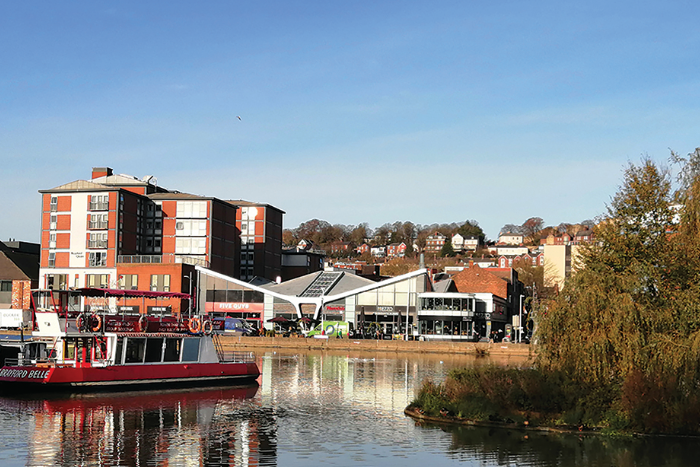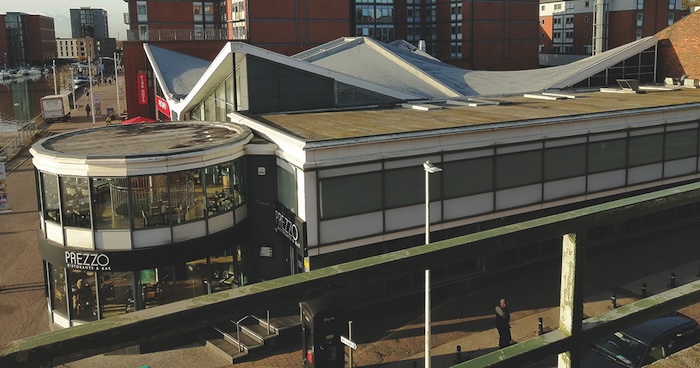
Former city car showroom’s roof was one of the first in Britain
Andrew Walker considers a distinctive building overlooking Brayford Pool, designed by a prominent city-based architect.
Some of Lincoln’s most prominent twentieth-century buildings were designed by city resident Hugh Segar (Sam) Scorer (1923-2003).
Brayford House, with its distinctive roof, was opened in 1959 as a garage and car showroom. From 1971, it became home to Lincolnshire County Council’s Library Support Services and, more recently, it has accommodated several restaurants.
When the building was nominated for listed status in 1999, its architect, Sam Scorer, observed that ‘The designing was very enjoyable and it is one of my favourites.’ He noted that ‘It is a lovely building with a shell structure and very thin walls. It had a revolving car stand to slowly turn cars around.’
The garage’s owners, the Lincolnshire Motor Company, sold Ford vehicles and, during the 1960s, many of its cars for sale echoed the design of the building itself, with the Zephyr, Cortina, Corsair, Consul Classic and Anglia all boasting angular features such as rear fins, and in the case of the Anglia and Consul Classic, adventurous backward-slanting rear windows.
The concrete-shell roof shape enabled a large span to be achieved, which meant that the garage interior was unencumbered with supporting columns, enabling the space to be used flexibly.
The building’s roof prompted much interest. The hyperbolic paraboloid structure, made of a reinforced concrete shell, was one of the first of its type to be built in Britain, and at the time, was the largest in the country.
The roof’s consulting engineer who worked with Sam Scorer on other projects, was Hungarian-born Dr Kálmán Hajnal-Kónyi, a pioneer of concrete shell construction in Britain.
A model of the roof was tested in the laboratories of the Cement and Concrete Association and, during the construction of the building, many engineers from across Britain visited the site to study its development.
In 1965, three engineers from Leningrad (now St Petersburg) and the Ukraine came to Lincoln specifically to see Brayford House as part of a UK tour studying the construction of concrete-shell roofs.
When the garage was first opened in September 1959, the Lincolnshire Echo declared that it was ‘brightening up the face of Brayford’. Amongst the guests at the official opening, alongside staff of the architectural firm Denis Clarke Hall, Scorer and Bright, and the building contractors George Walker, was Colonel J.E. Sanders, commander of the Royal Lincolnshire Regiment, TA. He commented that this was a ‘very remarkable building’ and ‘an example of courage and far-sightedness’.
The hyperbolic paraboloid roof structure was used by Scorer on other commissions, including at the Church of St John the Baptist on the Ermine estate, opened in 1963, as well as, perhaps most famously, at a petrol filling station, for which Hajnal-Kónyi was consulting engineer, and originally operated by Lincolnshire Motor Company, at Markham Moor on the A1 in Nottinghamshire, which was opened in 1961.
Sam Scorer’s other work in Lincoln included Lucy Tower Street multi-storey car-park (1974), Barclay’s Bank, High Street (1970), the Environment Agency building on Waterside North (1979), and Damon’s Restaurant (1988). Brayford House, then, forms part of Sam Scorer’s impressive and diverse architectural legacy.
For more information on The Survey of Lincoln see www.thesurveyoflincoln.co.uk. The Survey’s book, Lincoln’s Burial Grounds: Commemorating the City’s Dead, is available, priced £9.50, at Jews’ Court Bookshop, Steep Hill, and Lindum Books, Bailgate. The Survey’s book on Brayford Pool is also still in print.

